28/01: Alexandria
Category: General
Posted by: The Agnew Family
Alexandria is on the Mediterranean Sea and is approximately 230 km from Giza, so we were up at 5am, eating breakfast at 5:30am and on the road just after 6:30am. We were told that traffic might be bad but once we left the city streets and were on the highway we had clear sailing.
Alexandria was founded in 331 BC by 25 year old Alexander the Great. Alexandria's history bridges the time between the pharaohs and the coming of Islam. The city gave rise to the last great Pharaonic dynasty, the Ptolemies. Cleopatra was the last member of the Ptolemy family to rule Egypt.
First stop in Alexandria was the Roman Catacombs. These catacombs were discovered accidentally in 1900 when a donkey disappeared through the ground. These catacombs make up the largest known Roman burial site in Egypt. The narrow spiral staircase was almost enough to send claustrophobic me back to the surface but once we were down in the open chambers I was OK.
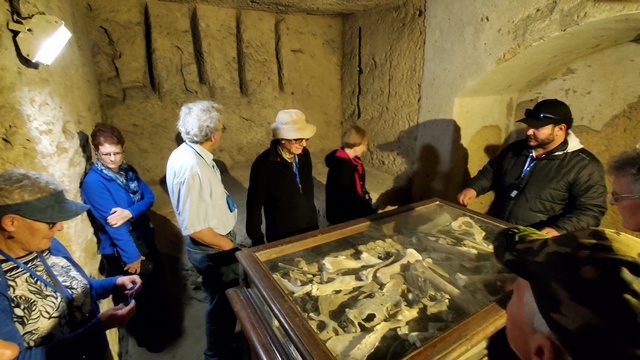
One of the rooms in the catacombs was found to contain horse bones. The archaeologists believe the horses were prized racehorse.
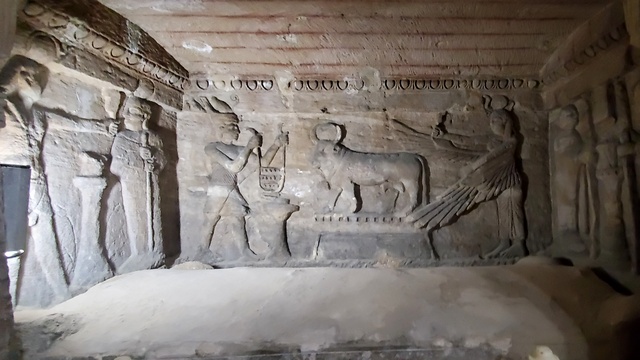
Another room in the catacombs had beautiful carvings. Outside of the room were 2 statues, one of a man and the other of a woman. The archaeologists believe that the man and woman were important just not important enough to have their own tomb.
Next stop was the Pompey's Pillar and the Temple of Serapeum. A massive 30 meter column towers over the debris of the ancient settlement of Rhakotis, the original town from which Alexandria grew. Pompey's Pillar is made from red Aswan granite.
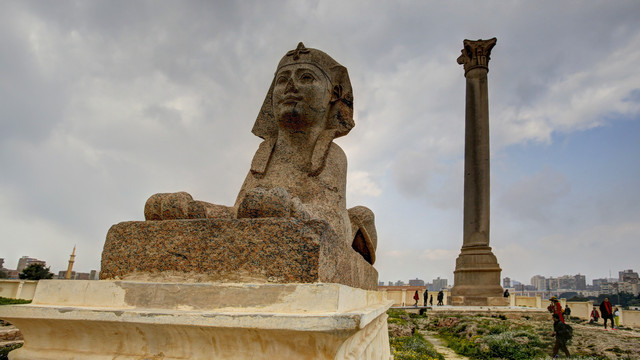
Pompey's Pillar is made from red Aswan granite. The photo shows one Spinx but there are actually 2 on the site. The photographic angle is showing the Spinx to be massive, it's actually a lot smaller than the pillar.
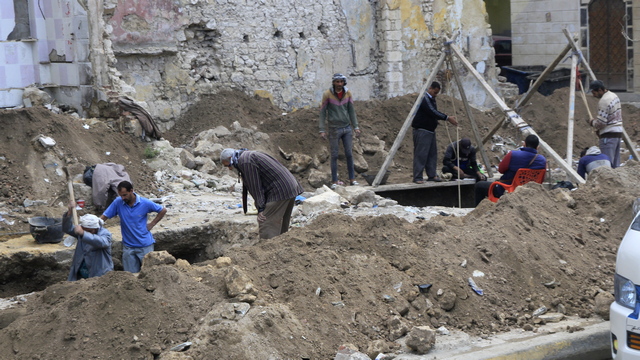
Across the street from Pompey's Pillar we saw men using a pickax and removing dirt from a hole with a bucket. The man sitting in the red chair was watching everything that came out of the bucket ---- were guessing he's an archaeologist overseeing the site.
The Roman Amphitheater dates back to the second century AD. It was discovered by chance in 1960 when some remains from Napoleon's time were being removed. The site includes an ancient Roman theater, baths and a villa with mosaics. Our guide believes that there are more remains under parts of the city.
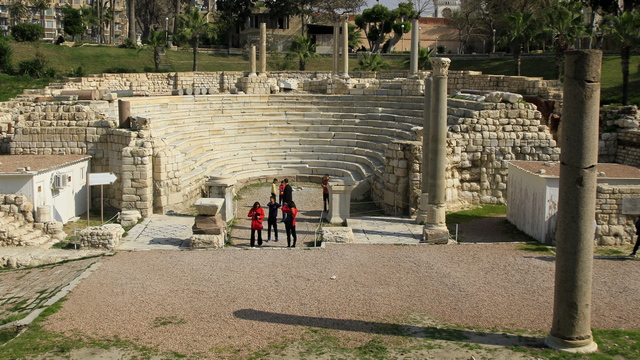
The theater.
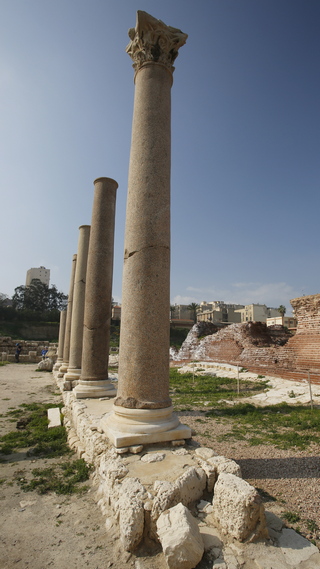
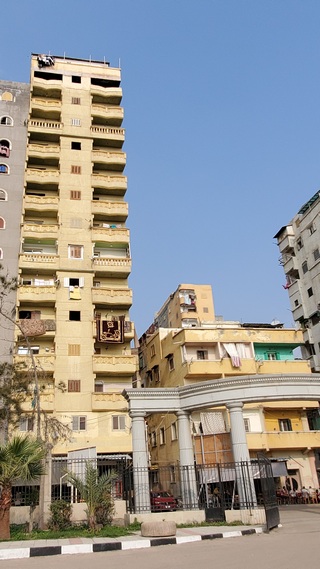
The photo on the left is of a row of pillars at the villa area of the amphitheater site. The photo on the left is a common scene so far in Eqypt. Laundry is hung from the balcony to dry. Not sure if it'll come in cleaner than before it was washed.
It is thought that the Ancient Library of Alexandria was destroyed in a fire in 48 BC. In 2002 the Bibliotheca Alexandrina opened. "The building takes the form of a gigantic angled discus embedded in the ground evoking a second sun rising out of the Mediterranean. The granite exterior walls are carved with letters, pictograms, hieroglyphs and symbols from more than 120 different human scripts."(borrow from Lonely Planet). The building was amazing and we wish we could have had more time to explore it but we needed to start the drive back to Giza.
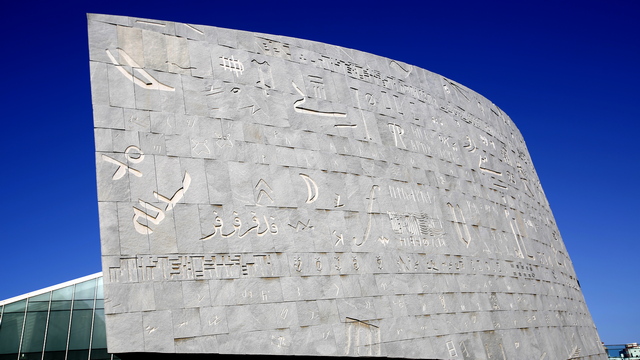
The outisde wall of the library.
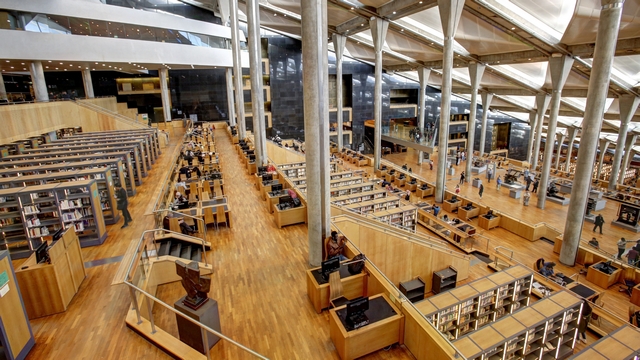
A view of the inside of the library.
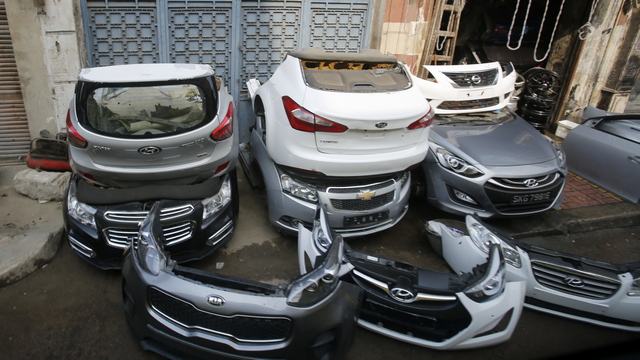
Alexandria is known for car parts as the city is home to a big part. What's really interesting is the "half car" parts. To avoid paying import taxes on a car it is cut in half. When you want a new car you just have to buy the front half, the back half and find someone to put it back together. Our guide told a story of how his brother did this then sold the car. The buyer didn't know and couldn't tell that the car had come in 2 pieces.
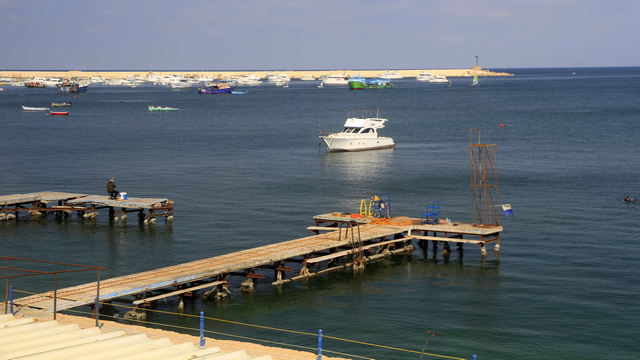
We enjoyed a wonderful seafood lunch overlooking the Mediterranean.
Alexandria was founded in 331 BC by 25 year old Alexander the Great. Alexandria's history bridges the time between the pharaohs and the coming of Islam. The city gave rise to the last great Pharaonic dynasty, the Ptolemies. Cleopatra was the last member of the Ptolemy family to rule Egypt.
First stop in Alexandria was the Roman Catacombs. These catacombs were discovered accidentally in 1900 when a donkey disappeared through the ground. These catacombs make up the largest known Roman burial site in Egypt. The narrow spiral staircase was almost enough to send claustrophobic me back to the surface but once we were down in the open chambers I was OK.

One of the rooms in the catacombs was found to contain horse bones. The archaeologists believe the horses were prized racehorse.

Another room in the catacombs had beautiful carvings. Outside of the room were 2 statues, one of a man and the other of a woman. The archaeologists believe that the man and woman were important just not important enough to have their own tomb.
Next stop was the Pompey's Pillar and the Temple of Serapeum. A massive 30 meter column towers over the debris of the ancient settlement of Rhakotis, the original town from which Alexandria grew. Pompey's Pillar is made from red Aswan granite.

Pompey's Pillar is made from red Aswan granite. The photo shows one Spinx but there are actually 2 on the site. The photographic angle is showing the Spinx to be massive, it's actually a lot smaller than the pillar.

Across the street from Pompey's Pillar we saw men using a pickax and removing dirt from a hole with a bucket. The man sitting in the red chair was watching everything that came out of the bucket ---- were guessing he's an archaeologist overseeing the site.
The Roman Amphitheater dates back to the second century AD. It was discovered by chance in 1960 when some remains from Napoleon's time were being removed. The site includes an ancient Roman theater, baths and a villa with mosaics. Our guide believes that there are more remains under parts of the city.

The theater.


The photo on the left is of a row of pillars at the villa area of the amphitheater site. The photo on the left is a common scene so far in Eqypt. Laundry is hung from the balcony to dry. Not sure if it'll come in cleaner than before it was washed.
It is thought that the Ancient Library of Alexandria was destroyed in a fire in 48 BC. In 2002 the Bibliotheca Alexandrina opened. "The building takes the form of a gigantic angled discus embedded in the ground evoking a second sun rising out of the Mediterranean. The granite exterior walls are carved with letters, pictograms, hieroglyphs and symbols from more than 120 different human scripts."(borrow from Lonely Planet). The building was amazing and we wish we could have had more time to explore it but we needed to start the drive back to Giza.

The outisde wall of the library.

A view of the inside of the library.

Alexandria is known for car parts as the city is home to a big part. What's really interesting is the "half car" parts. To avoid paying import taxes on a car it is cut in half. When you want a new car you just have to buy the front half, the back half and find someone to put it back together. Our guide told a story of how his brother did this then sold the car. The buyer didn't know and couldn't tell that the car had come in 2 pieces.

We enjoyed a wonderful seafood lunch overlooking the Mediterranean.